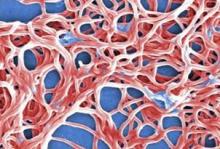ATLANTA – Women with Lyme disease display more clinical symptoms than do men with the disease and also are less likely to seroconvert following treatment, according to findings from a prospective cohort study involving 77 patients.
Numerous symptoms were reported more often by the 37 women in the study than by the 40 men. For example, significantly more women than men reported joint pain, muscle pain, headache, back pain, heart palpitations, nausea, vomiting, anxiety, numbness and tingling, and changes in vision during at least one of six preplanned study visits with a physician, Lauren A. Crowder, M.P.H. reported in a poster at the International Conference on Emerging Infectious Diseases.
Joint pain, heart palpitations, nausea, vomiting, and changes in vision were reported significantly more often by women at two of the six visits, and headache was reported significantly more often by women at four of the six visits.
"The second preliminary finding we observed in our cohort of patients was that women were less likely to seroconvert on the antibody tests for serodiagnosis of Lyme disease," Ms. Crowder of the Lyme Disease Research Foundation, Lutherville, Md., said in an interview.
At the initial study visit, a similar proportion of men and women (about 60% of each) tested negative for Lyme disease using the Centers for Disease Control and Prevention’s recommended two-tier testing criteria for serodiagnosis. However, at the second visit, which was performed immediately post treatment, 70% of women who tested negative at the first visit remained negative, compared with only 35% of the men who initially tested negative.
Additionally, polychromatic flow cytometry performed on patient samples indicated that women had significantly higher frequency of CD4+CCR5+ T-cells prior to treatment than did men (mean of 9.82% vs. 5.96%).
"These findings suggest to us that there may be a difference between how men and women respond to infection with Lyme disease. One hypothesis for these differences is that there may be an immunological variation in response to Borrelia burgdorferi, the bacterial infection that causes Lyme disease, between men and women," Ms. Crowder said.
Study participants had early, untreated erythema migrans and clinically confirmed Lyme disease. At the first of the six study visits, they were tested using the CDC criteria by a commercial laboratory. All were treated with 3-week course of doxycycline and were then followed for up to 2 years. At each study visit, participants underwent a physical examination and interval history, reported clinical symptoms and completed self-administered surveys, and underwent repeat laboratory evaluations.
The findings highlight a need for additional research on sex-based differences in the effects of early Lyme disease. Such differences have been seen in other infectious disease, but have not been thoroughly explored in early Lyme disease, Ms. Crowder noted.
Such study is important given that Lyme disease is the most common vector-borne infectious disease in the United States. Although most patients recover from acute infection with proper antibiotic treatment, a subset of patients develop Post-Treatment Lyme Disease Syndrome. The CDC defines this syndrome as involving lingering symptoms of fatigue, pain, or joint and muscle aches. In some cases, these can last for more than 6 months.
"We will continue to explore these suggested differences both in this cohort and in future research studies," she said.
Ms. Crowder also stressed the importance of encouraging patients to look for ticks if they live in Lyme endemic areas.
This study was supported by the Lyme Disease Research Foundation. Ms. Crowder had no disclosures to report.

